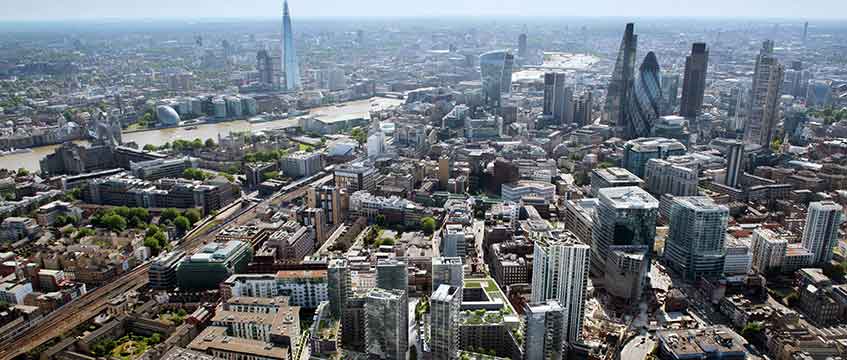City of London towers: more, bigger, taller
Bullish developers are seeking to build taller towers in the City of London as planners consult on intensifying the Square Mile’s skyscraper cluster.
Stanhope and Mitsubishi Estate submitted plans this week to scale up the consented Mitsubishi Tower by 10 floors to 50 storeys. This followed AXA Investment Managers – Real Assets last week reverting to its consented plan for a 62-storey tower at 22 Bishopsgate, EC2, after shaving 65ft off the plans in December, citing a “different economic climate” and “changing workplace practices, new technology and differing occupation densities.”
City planners are also having discussions with developers on about “four or five” other sites that have the potential to become tall buildings, said Gwyn Richards, head of design at the City’s planning team.
Bullish developers are seeking to build taller towers in the City of London as planners consult on intensifying the Square Mile’s skyscraper cluster.
Stanhope and Mitsubishi Estate submitted plans this week to scale up the consented Mitsubishi Tower by 10 floors to 50 storeys. This followed AXA Investment Managers – Real Assets last week reverting to its consented plan for a 62-storey tower at 22 Bishopsgate, EC2, after shaving 65ft off the plans in December, citing a “different economic climate” and “changing workplace practices, new technology and differing occupation densities.”
City planners are also having discussions with developers on about “four or five” other sites that have the potential to become tall buildings, said Gwyn Richards, head of design at the City’s planning team.
Intensification planned
The new plans come as the City considers an intensification and possible expansion of the eastern cluster through its local plan (see box). The area is identified in the City’s core strategy as being able to accommodate significant growth in office floor space and employment “by delivering tall buildings on appropriate sites”.
Christopher Hayward, chairman of the planning and transportation committee, said the corporation was looking at how it could “infill” between the Cheesegrater at 122 Leadenhall Street, EC3, and the Walkie Talkie at 20 Fenchurch Street (just outside the eastern cluster that is a focus of the consultation) with taller buildings.
Planners are using 3D-technology to assess the impact of proposed new tall buildings on wind, sun, air pollution and noise to help identify additional sites. They are also looking at how infrastructure improvements and consolidation centres for online deliveries outside the Square Mile could help reduce congestion and allow for more development.
The rethink of the Mitsubishi Tower follows Brookfield Property Partners’ consent for a 37-storey tower across the road at 1 Leadenhall Street, EC2. Extending the height of the tower at 6-8 Bishopsgate will create an upward slope towards the central group of taller buildings in the cluster where Aroland Holdings’ consented 1 Undershaft will be the City’s tallest building at 1000 ft.
Stanhope chief executive David Camp told EG last month that changes to 6-8 Bishopsgate were “because of other consents that have now been granted around it.
“Proportionately it doesn’t seem quite right, so we’re looking at whether we can improve that space, particularly because it’s got a prominent viewing gallery so that it still has a good view from the top.”
He added: “I think people like tower space and it is much more appropriate for a whole range of tenants rather than just banking people, so I think more tower space in the City will happen over time, and I think the City corporation is encouraging it.”
The City currently has 93.8m sq ft of office development with a further 13.5m sq ft under construction, according to the corporation.
City take-up falls off
The development appetite comes despite disappointing Q1 take-up figures for the City core. EGi London Office Market Report figures published last week showed a year-on-year fall of 21% to 739,634 sq ft while the availability rate was 7.32% – up by 40.8% year on year. However, the City remains confident about its evolution, with the corporation pitching the Square Mile as the original and future co-working/tech hub.
Lee Elliott, head of commercial research at Knight Frank, predicts that more tech occupiers that have recently been locating in the City fringe will move back into the City core as its amenity offer improves and rents level out.
The ‘City 2036’ consultation: key points
Planners are considering responses to possible changes to the eastern cluster through the local plan “City 2036” consultation.
Key considerations are:
■ Should further intensification be encouraged within the eastern cluster? Should the current policy area be retained or should it be modified?
■ What changes would be needed to existing infrastructure to accommodate further intensification in the eastern cluster?
■ Should special emphasis be placed on the public realm to cope with increased pedestrian movement in the eastern cluster?
The consultation results will go to committee in November. A further consultation will then take place between December and February 2018.
Why ramp up the eastern cluster?
The City Corporation says it will need to accommodate an additional 50,000 workers in the next 30 years. However, the City is running out of available sites and it can only build up, not out.
Uncertainty following the decision to leave the EU could affect the development programme of current and proposed towers and the City wants there to be a flexible approach to planning to ensure that appropriate development can continue to come forward in the area.
To send feedback, e-mail Louisa.Clarence-Smith@egi.co.uk or tweet @LouisaClarence or @estatesgazette











